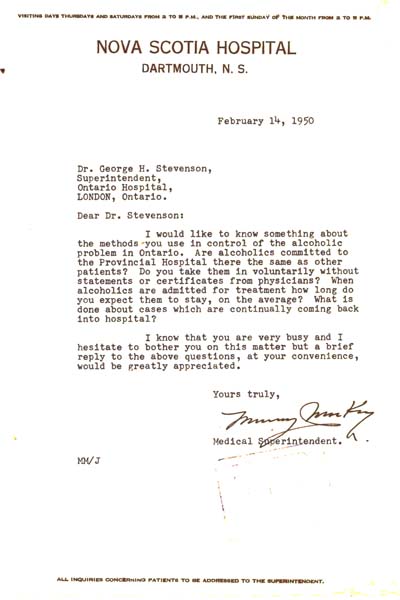The Role of Alcohol in Asylums

Letter from Dr. Mckay to Dr.
Stevenson, dated Febuary 14th 1950, asking about the committal of alcoholics to Ontario asylums.
1 |
2 |
3
Before the development of medication, most asylums used alcohol as a sedative. Its popularity as a treatment option reflected the views of society. As the temperance movement gained strength alcohol became less popular in asylums, it would see a rise in popularity again in the 1920s but was soon recognized as a harmful substance, as doctors became more knowledgeable about Alcoholism.
In 1874, the London Asylum reported that they had spent $1,850 on spirits, wine and beer. Although this figure was no different than that reported by Toronto Asylum, Dr. Henry Landor attempted to lessen the use of alcohol the following year, after he received complaints from the Provincial Legislature. According to his report in the Sessional Papers for 1875, this resulted in an increased death rate, and alcohol expenses for that year ($1997.41) remained relatively the same.
When Dr. R. Maurice Bucke became superintendent of the Asylum, he instituted a program to reduce the use of drug-based therapies. Dr. Bucke was especially concerned with the use of alcohol as a treatment, since he felt it was of no benefit to the patients, and in many cases, worsened, rather than helped their condition. By 1884, Dr. Bucke was proud to announce in his annual report that they had reached their second year "in which [the] nine-hundred patients [had] been total abstainers." In his publication Alcohol in Health and Disease, Dr. Bucke described the case of a female patient in his care: "This woman had not set up for many months, she lay on the bed or sofa all the time . . . my chief assistant said 'if you take away her wine she will die.' And I put off taking it from her, for I was uneasy as to the consequences of the step myself. At last, over a year ago now I did stop it. In a few weeks afterwards she began to sit up, and she has sat up and walked about everyday since." Dr. Bucke was not alone in his views regarding alcohol; the Hamilton Asylum stopped using it in 1880.
The 1920s would see a return in the popularity of alcohol as a treatment at the former London Asylum under Dr. George H. Stevenson. The treatment went out of favor again in the 1950s when Alcoholism was recognized as a disease, and alcoholics were occasionally admitted as patients to asylums under the Mental Health Act.